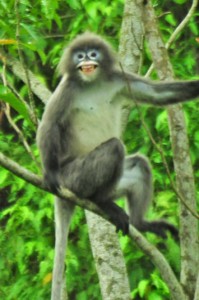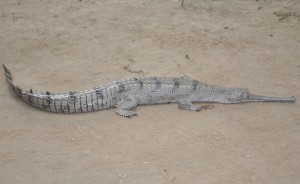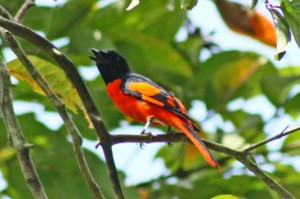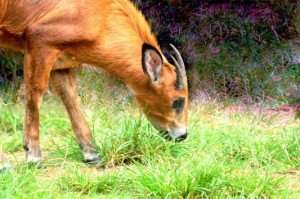Recently I had traversed a large part of the country for searching wildlife. During this visit I had came across a numbers of rare wildlife and ecosystem which might be of interest to the wildlife enthusiast. The reason why I felt to present my field notes.
Padma-Jamuna River Nature Trail
We board on a small flat-bottom boat powered by water pumping engine from Talamari at Rajshahi. A boy cum assistant of the owner of the boat started the engine by a handle and we are literally covered with a sudden on rush of black smoke on our noses and eyes and then the boat started towards Charghat for searching Gharial (Gavialis gangeticus) a species of reptiles thought to be extinct locally in Bangladesh. The captain of the boat assured us that a remnant population of Gharial is still exists at Khidirpur near Rajanagar border of India. Before we started our journey a group of people surrounds us and pierced with hundreds of questions. Who are you? Why you are here? Are you engaged in border smuggling? & so on. Our seasoned team leader Dr. Sheik Mohammed Abdur Rashid replied that we are here from Dhaka to search whether there exist a single individual of Gharial in this part of the river . Here are my team members Dr. Anis and Mr. Simanto Dipu. I myself is the Project director of “ Gharial Project.” One self made spokesman of the crowd told that the Baisal local name of Gharial is no more seen here. Do not go to this tense border because BSF of India just killed one teenager yesterday.
But our Team Leader Dr. Rashid gave green signal to the captain avoiding the potential threats and the boat started moving. We saw a flock of migratory birds roosting on the mudflats of a newly accreted charland . Species are Ruddy Shelduck, Eurasian Wigeon and Northern Shoveller associated with Eurasian Curley, Red-wattled Lapwing and Black kites. Boat makes a right turn towards Char Khidirpur under a deem sunlight and moving with a high noise sounding like “Vot vot vot”… We got down on a newly accreted sand dunes/bars and looking through our binoculars. Astonishingly we saw a peregrine falcon at the edge of char waters a rare migratory bird of prey. We had recorded Small Bangla Pratincole in a large flock, Ruddy Shelduck and Green-winged-teal. We again boarded and moved to char Khidirpur. On our way we saw small fishing boats catching tiny fishes. While searching the river banks for Gharial’s tracks and we found very big flocks (100+) of River bank myna nesting on the eroded banks. Holes were engraved on the river bank and pairings going on.
At Khidirpur the river courses were changed and the flows entered towards Rajanagar of India. A small population of Gharial which we studied in 1987 in char Khidirpur is no longer there. Char Khidirpur was a breeding ground of Gharial and there were 3 adult Gharials at that time. They used to lay eggs on the sandy banks of the river. During those days a few juveniles were collected from Char Khidirpur and reared at Rajshahi Zoo. Dr. Reza Khan, Journalist Mr. Mijanur Rahman of the Dainik Barta, a daily news paper and Dr. Farid Ahsan with the help of Bangladesh Rifles’ Jawans took the historic steps of captive rearing of Gharials in Rajshahi Zoo.
In the afternoon we cruised towards Charghat to search the Gahrial but we failed to locate any specimen of Gharial. According to the near by BDR Camp and the local fisherfolk they encountered few juveniles of Gharial during monsoon. They are rarely seen basking on the charland sandunes.
Near the Groin of Ichamati river at Charghat a group of 5 individuals of river lapwing a rare waterbirds which is critically endangered were seen feeding .
Ganges River Dolphin surfacing in good numbers along our cruise in the Ganges. The school varies from 2 individuals to 5. Boatman told this creature got entangled
Our second lag of journey we took from a ferry station at Gaibanbandha. Once this station was very busy and famous because of its link with the Jaganathganj rail ferry. After the construction of Jamuna Bridge, now only the local boats plying between chars and the land mostly to carry goods of local consumption. We rented one local boat for our Gharial survey. The boat we travelled is too long which .usually used for carrying the crops from charland to the mainland. This part of the river was once very important habitat of Gharial. There were several sighting records of Gharial in this stretch of the river during 1975-1980. We have cruised 30 km upstream of Jamuna river but we could not find any sign of Gharials in the river jamuna. According to local char dwelling people , they saw juvenile Gharial only in the monsoon season.
Interestingly we saw a good numbers of Spotbill Duck which is a resident duck of Bangladesh and used to breeds in the cahrlands of the river Jamuna. We also saw a large flock of and Ruddy Shelduck during this time of the year which is a rare sightings.. Important sightings of our cruise at Jamuna are: Black Stork, Lesser Spotted Eagle, River Lapwing, Peregrine Falcon, Great cormorant and Bengal Pratincole and Red-wattled Lapwing.
(Will Continue…)
Bandarban Wilderness
Bandarban is the regional evergreen forest biodiversity hot spot at the juncture of Indo-Malayan and Indo-Himalayan sub-region of the Oriental region. The Sangu river valley is home of more than 2000 species wild flora and + 1000 species of wild fauna. Among them rare ones are: Asian Elephant, Goat Antelope, Malayan Sun Bear, Binturong, Malayan Giant Squirrel, Himalayan Flying Squirrel, Hog Badger, Clouded Leopard, Golden Cat, Sambar Deer, Barking Deer, Hispid Hare, Pygmy Hog, Phayre’s Leaf Monkey, Holoock Gibons, Capped Langur, Assamese Macaque, Pig-tailed Macaque, Slow Loris, Hill Partridges, Hill Mayna, Greater Hornbill, Fairy Blue Bird, Green Malkoha, Green Magpie, Forest Eagle Owl, Red-headed Trogon, Elongated Hill Tortoise, Indian Python, King Cobra, Crab-eating Mongoose, Ring Lizard and Green Pit Viper. A numbers of Hill streams join together and gives raise rivers in Bandarban which are very rich in stream dwelling fish and amphibians.
We took two flat bottom local boats to cruise the river Sangu. A river originates within Bangla territory runs through hills and finally merged into the Bay of Bengal. This river runs from the east to west .Water is transparent but shallow all along except few duars. These duars are the deepested hole of the river and the fish winter there as refuge. Hill stream fishes use these duars as the breeding ground. Both the banks of the river are enclaves by medium to high hill ranges. River bottom could be seen clearly by naked eyes. River bed is mostly sandy mixed with pebbles and swimming juveniles of fishes. At all meandering a wide veranda of rolling stones covered with aquatic weeds and dense deep green algae. The colonies of Rakata Karobi forms bushes and the butterflies and dragon flies are making their nuptial flight over the bushes. Bank dwelling birds were seen feeding insects and water bugs along the spiral bended of the river. Commonly seen birds are Pied Wagtail, Grey Wagtail, Marsh Warbler,Pied Bushcaht, White-throated Kingfisher and Striated Munia
Our journey starts towards upstream of the river. Early morning, less people are visible on the bank. We approached our left bank where the hill wall rises straight to the sky. The walls of the hill are multicolored because of the growth of moss, lichen, ferns and climbers. We saw a nice hanging reed plants with pink colored flower. This reed plant is a hanging orchid grows on the moist hill walls deep inside forest. Flowers are brilliant pink color. Local name of this ground orchid is “Nalrasna”.This plant grows on wall of hills at high altitude. The associates are ferns, grasses, vines and creepers which forms multicolored velvety mosaic on the hill walls. . Nectar feeding birds are seen hovering over the flowers of epiphytes. Flame-backed flycatcher, long-billed purple Sunbird, Fire-breasted Flycatcher and Spider Hunter were seen in this specialized ecological niche.
We entered into a narrow hill stream. The water is falling slowly along the jig jag path. There are steps of uneven rocks/boulders, small to medium waterholes are full of tadpoles. These small pools are good abode of frogs and tiny fishes. We saw crustaceans, water bugs, snails and dragonflies in good numbers. Among the frogs the species are : The water is stagnant and full of large quantities of fallen leaves. Rotten leaves are the source of the pool dwelling wildlife.
It’s cool, shady and culms inside the stream. Evergreen plants with their leafed branches forms green roof over the stream. Spiders made their nets in between two tree ferns. Sandstone of different sizes rolls in the water. We heard calls of whistling thrush and squirrel up above the stream. Forktail bird with their contrasting black and white color feeding on the insects of the stream. The tail is waving up and down with clearly defined rhythms. Chorus of Racket-tailed drongos listened together with other mixed-hunting party members. Other members are: Ashy drongo, Georgette neck laced babbler and fan-tail flycatcher. In the forest a group of birds belonging to different species forms hunting party. This group used hunt preys together whether flying insects, butterflies, moths, mosquitoes or aphids. There are two shrews crossing the stream and searching food here and there.
Most astonishingly we discovered a group of Assamese Macaque roaming on the upper canopy of the forest. They were 7 member groups. The groups were feeding tender leaves which are very scarce. Most of the feeding trees are cut downed for timber logging whether legal or illegal.
The prominent sorrow scene of the bank of the river is tobacco cultivation. One multi-national tobacco company has been engaged in motivating, organizing the local community in this practice since long through a comprehensive package. This cultivation of tobacco in hill valleys and river valleys are reducing winter crop cultivation to a greater extent. This posing an additional threat to the hill biodiversity by uncovering the natural shrub lands/forest. Excessive water is being extracted from the hill streams to irrigate the tobacco field.
They also took lease of huge hill ranges in the name of afforestation which is nothing but monoculture forestry. They are planting rapid growing fire fuel timber plants importing from abroad. All these are exotic plants are detrimental to local natural environment. All these short rotation plants after harvest are using in their tobacco burn to treating Flue Cured Virginia (FCV). According to local vendors of the company, most of the FCV are exporting outside after meeting their local factory demands. It is to be noted that growing tobacco is banned in some countries. Hence they are happy to grow tobacco here in Bangladesh in the name of development and helping poor people.
Haors are the natural heritage of Bangladesh. Fresh water is in its purest forms. Thousands of hill streams merged and forms these bowl=shaped depression. Some are shallow and some are very deep deep as 10 to 15 meters. Water from the hills like the Meghalaya and Assam runs through these nice haors to our rivers in down streams. Tje water in the haor
So clean and transparent that you can see the submersed water plants even the color of those plants. U also enjoy the variety of colorful fish from tiny to giant in size. Massive growth of aquatic plants are seen in good abundance. These are free floating, rooted floating, submersed, reeds, grass, and swamps. Freshwater swamps are the rarest kinds of forest in our country nowadays. Only could be seen Haor biomes.
Forest biological diversity is a broad term that refers to all the life forms found within forested areas and the ecological roles they perform. As such, forest biological diversity encompasses not just trees but the multitude of plants, animals and micro-organisms that inhabit forest areas and their associated genetic diversity.
Forest biological diversity can be considered at different levels, including the ecosystem, landscapes, species, populations and genetics. Complex interactions can occur within and amongst these levels. In biologically diverse forests, this complexity allows organisms to adapt to continually changing environmental conditions and to maintain ecosystem functions.
Author : Dr. Anisuzzaman Khan, Photo Courtesy : Mr.Munir Ahmed
e-News® Xclusive








































